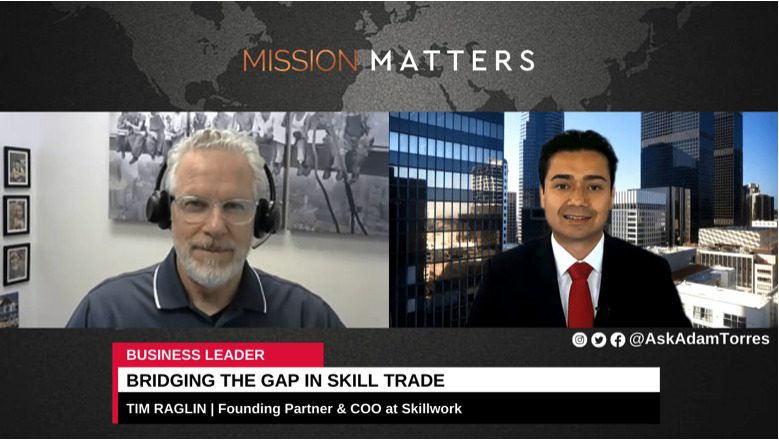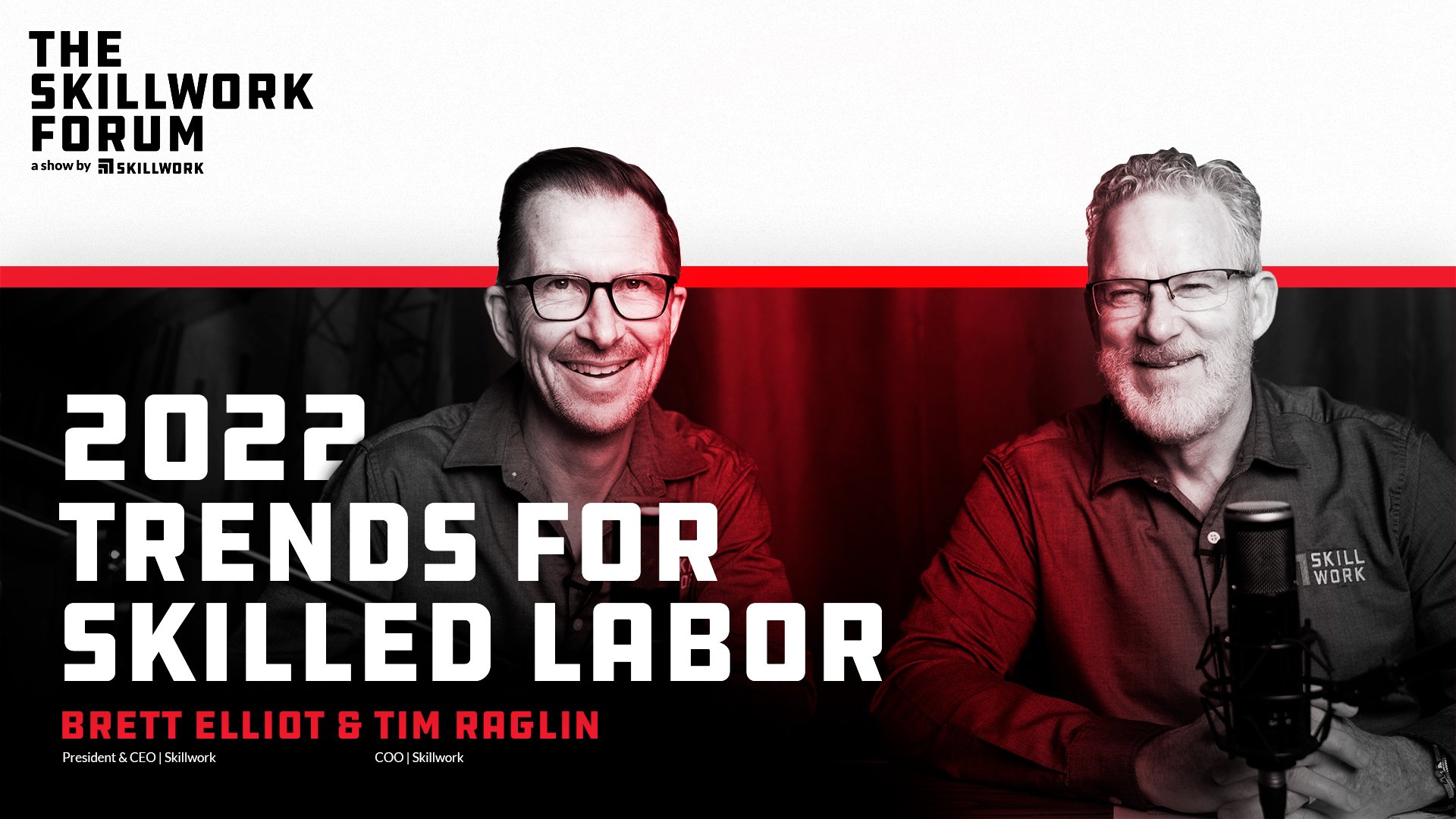The 8 Trends You Need To Know About The Skilled Worker Shortage in 2020

The skilled worker shortage is a huge stress on companies today. While it’s a complicated problem with many different solutions that will take time to implement, our team at Skillwork discovered some insights that might help you weather the storm. Read on to learn about the 8 most significant trends related to the skilled worker shortage.
1. The labor shortage will continue to get worse.
Unfortunately, the problem is real, and the challenge will continue into the foreseeable future.
There is a projected shortage of over a million skilled workers in 2020 and that number is expected to rise to at least 2 million by 2025. Young people aren’t pursuing the skilled trades like they used to and the aging workforce (primarily consisting of baby boomers) will be leaving over the next 5-7 years – and they’ll be taking decades of expertise and experience with them.
It’s a problem that’s slowly been created over the last 20 years, and traditional methods used to address staffing shortages aren’t as effective as they used to be.
2. HR spending will go up.
Companies recognize the huge problem of the labor shortage and are allocating more resources (time, money, personnel) to try to fix it. In fact, HR budgets and spending are set to increase by 10% in 2020 to try and fix the problem. Companies are hiring more in-house recruiters, establishing lucrative hiring bonuses and incentives, and creating new employee benefits and training.
The irony in this increased spending is that while companies are increasing their HR budgets, they fully expect to hire fewer, less qualified people. This indicates many will be spending more for poorer results and lower confidence in the process.
While it’s a great idea to invest and focus on these traditional methods, the lack of results indicate that it’s time to consider adding alternative methods to your toolbox.
3. Vetting and testing employees will continue to be increasingly important.
Pre-employment testing, including personality, cognitive, and skills-based testing, is now considered the third most critical factor in respect to hiring (only behind traditional interviews and resume searches). The cost of selecting and hiring the wrong employee can be significant, so anything companies can do to increase the quality and likelihood of a new hire being the right fit is crucial.
There are some excellent and powerful tools for testing available to employers, but they can be complicated and take time to learn how to use. Many companies simply do not have the resources or time to employ these tools effectively, so a valuable capability often goes unused. Outsourcing this capability makes good economical and functional sense.
Skillwork has invested countless hours customizing the right package of optimized testing and vetting for each of our clients – particularly those seeking high-quality skilled tradespeople. We help ensure you find the right person for the right job at the right time. Since it is extremely costly to hire the wrong employee, why not let Skillwork do the heavy lifting? Let us be the experts and carry the risk for you.
4. Automation, robotics, AI, and machine learning trends will increase.
Over the years, automation has increased as a solution for the skilled labor shortage. It comes with many benefits, including increased efficiency and productivity. But the downside is that the advanced equipment requires highly trained and skilled technicians to maintain and repair it.
Companies are finding that while technology has increased productivity, it’s left a huge gap in the ability to hire the right maintenance personnel. Finding these skilled workers, particularly in more rural manufacturing locations, will continue to be a growing challenge and companies will have to widen their search and look for innovative placement strategies.
If your company would like help finding workers for these highly specific needs, click this link to have a Skillwork team member walk you through our solution.
5. Middle and high schools will continue to push college over trade school.
Our culture is in a place where, even though the college student debt crisis is at an all-time high, there is still a negative stigma around students choosing to pursue the skilled trades instead of a 4-year degree. High schools measure their success and receive funding based on how many students they push to traditional 4-year colleges.
Meanwhile, they minimize the importance and opportunities in the skilled trades, even though they provide job security, flexibility, and the chance to make a great living without being saddled with debt. Even though we are seeing positive trends to counter this cultural influence, we anticipate this ideology to persist for the near future.
Unfortunately, it will take time to influence the culture and provide more opportunities for young people to pursue trades and will require long-term investment in training, mentoring, and development.
6. ’Ghosting’ will increase.
Nearly 85% of HR professionals say that they have experienced “ghosting” – and that number will continue to rise. If you aren’t familiar with the term, ghosting is when a candidate that has been vetted or even accepted a position with your company suddenly stops all communication or fails to show up on the first day. Suddenly, and without warning, all that time, energy, and financial investment made to land that new employee is gone.
This places a huge drain on both time and resources to many companies, further exacerbating their already chronic staffing issues. Since there is a high demand for skilled tradespeople in the market, candidates have more options to choose from, which only exaggerates this trend.
“Staffing companies are not immune to this phenomenon, but when you partner with a company like Skillwork, you transfer staffing risk to us. We manage the ghosting that inevitably takes place so you can concentrate on your business.”
7. Most solutions won’t offer immediate results.
Talent has been draining from the skilled trade space for the past 15-20 years, so, unfortunately, it won’t be solved overnight. Companies are feeling the pain of the shortage and scrambling to fix it with things like increasing their HR spending, investing in trade schools, and providing internal training, just to name a few.
However, those are long-term solutions and don’t solve the shortages that you are experiencing today. Business leaders need to think outside the box to create immediate solutions while the long-term investments have time to catch up.
8. Employee satisfaction will continue to decrease.
Because of the skilled labor shortage, companies are faced with the choice between not having the employees they need or lowering their standards so they can fill those positions. This can create all sorts of problems – lowering morale, decreasing productivity and efficiency, and even raising safety concerns, as experienced workers have to spend more time training and overseeing the inexperienced members of the team. Lowering the bar and accepting lesser talent only creates frustration within your company – but it doesn’t have to be your only option.
While the skilled trade shortage is a daunting problem to overcome, we are confident that a combination of immediate, short-term, and long-term solutions will gradually change the tide. This is where Skillwork comes in. Our proprietary supplemental labor model provides a new method to find the people you need without sacrificing employee talent or your hard-earned resources.
Let us do the heavy lifting in your hiring process. Click here to get in touch with a Skillwork representative who can get you the help you need, when you need it.

